Milk kefir changes during fermentation due to the complex interactions between beneficial bacteria and yeasts in your kefir grains. As these microorganisms work together, they'll break down lactose into simpler sugars, producing lactic acid and other compounds that transform your milk. You'll notice the milk thickening, developing a tangy taste, and sometimes separating into curds and whey. The process typically takes 24 hours at room temperature, with distinct stages marked by changes in texture, acidity, and flavor profiles. Understanding these transformations can help you achieve your perfect batch of homemade kefir.
The Science Behind Kefir Formation
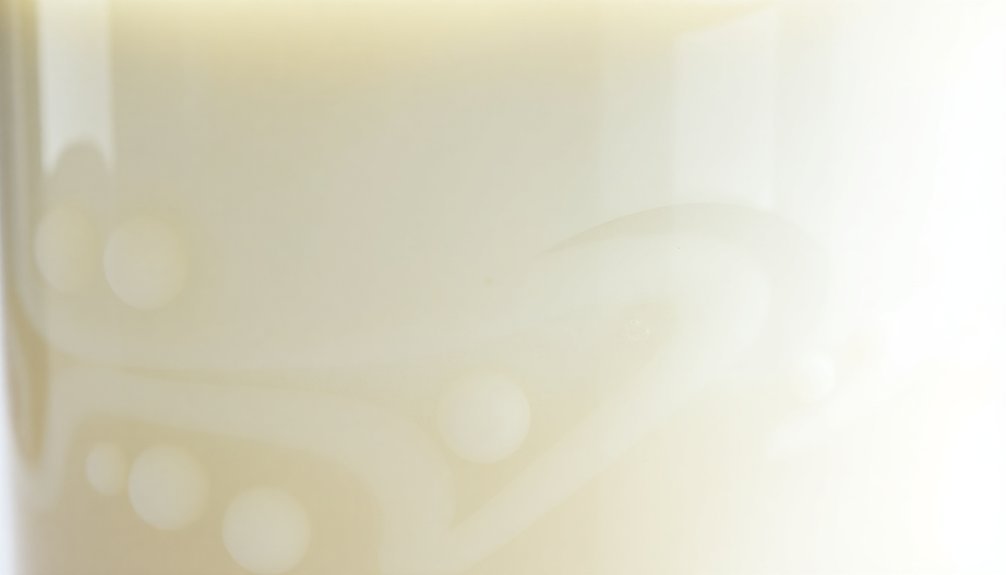
How does a simple mixture of milk and kefir grains transform into a nutrient-rich, fermented beverage? The magic happens through a complex interaction of microorganisms found in kefir grains, including lactic acid bacteria and yeast. These tiny organisms work together to break down the milk's components through fermentation.
When you add kefir grains to milk, the microorganisms begin multiplying and feeding on the milk's contents. The lactic acid bacteria convert lactose (milk sugar) into lactic acid, which gives kefir its characteristic sour taste. Meanwhile, the yeast produces small amounts of alcohol as a byproduct of fermentation. Proper airflow through loose covering is crucial for successful fermentation. This process typically takes place at room temperature for about 24 hours, though you'll notice the timing can vary based on temperature conditions.
During fermentation, the microorganisms extensively break down milk proteins, creating 1,591 peptides, with 609 being unique to kefir. These peptides aren't just byproducts – they're biologically active compounds that can provide antimicrobial, antihypertensive, and immunomodulatory benefits.
You'll know your kefir is properly fermented when it develops a thicker consistency, a tangy taste, and reaches a pH between 4.0 and 4.5.
Understanding Lactose Breakdown Process
The complex process of lactose breakdown lies at the heart of kefir fermentation. When you add kefir cultures to milk, they immediately begin splitting lactose, the milk's natural sugar, into simpler forms: glucose and galactose. The bacteria in these cultures release lactase enzymes, which facilitate this essential breakdown process without requiring your body's natural lactase. The 14-18 hour fermentation ensures thorough lactose reduction.
You'll find that multiple strains of bacteria and yeast work together during fermentation, converting these simple sugars into various compounds. The glucose gets transformed into lactic acid through homofermentation, while other byproducts like pyruvic acid, acetic acid, and acetaldehyde emerge, creating kefir's distinctive taste profile.
If you're lactose intolerant, you'll be pleased to know that this breakdown process makes kefir more digestible than regular milk. The fermentation notably reduces lactose levels, and the slower transit time of fermented dairy products helps your body process any remaining lactose more effectively.
While some lactose may still be present in the final product, most lactose-intolerant individuals can consume kefir without experiencing typical digestive discomfort.
Temperature Effects on Fermentation
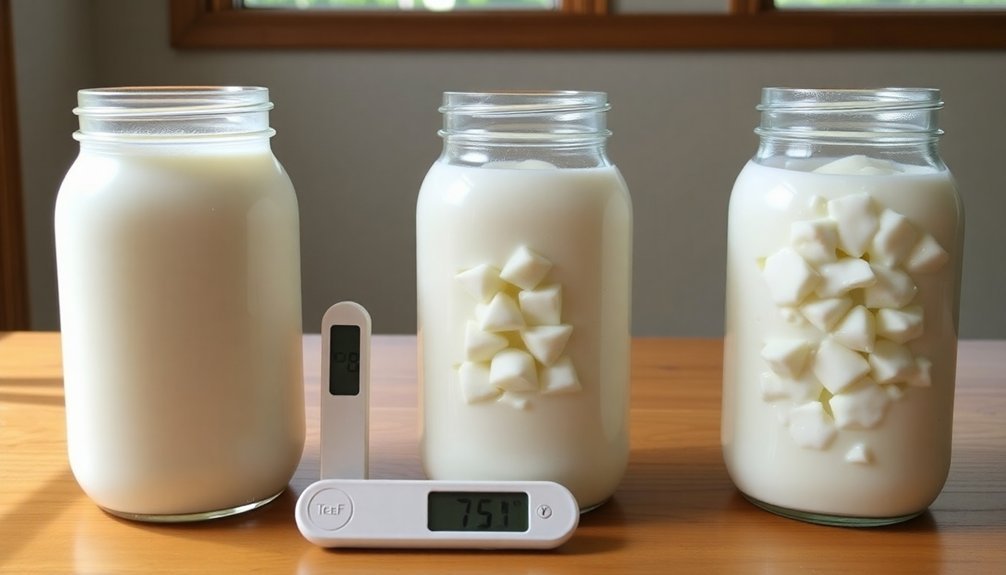
Building on our understanding of lactose breakdown, temperature plays a major role in how quickly and effectively your kefir ferments.
You'll get the best results when you maintain temperatures between 20-30°C (68-86°F), with 22°C (71°F) being preferred. At this ideal range, you'll typically achieve fermentation within 24 hours and produce a creamy, well-balanced kefir. The microbial activity peaks during this temperature range, maximizing the transformation of lactose to lactic acid.
If your fermentation environment is too warm (above 30°C), you'll notice your kefir becoming more sour and thinner in texture, while potentially damaging your grains.
Conversely, when temperatures drop below 20°C, fermentation slows dramatically – it can take 3-5 days in the fridge. You'll need to adjust your grain-to-milk ratio based on your climate: use 1:7-1:15 in cold conditions and 1:20-1:60 in warmer environments.
To maintain consistent quality, you can manage temperature fluctuations by using cooling methods like ice packs in hot weather or finding warmer spots in your home during winter.
You'll want to avoid exposing your kefir to temperatures above 86°F (30°C), as this can harm your grains and compromise the final product's texture and flavor.
Microbial Activity During Fermentation
During kefir fermentation, you'll find that lactic acid bacteria like Lactobacillus and Lactococcus begin converting lactose into lactic acid, leading to a gradual pH decrease in the milk.
You'll notice that yeasts work simultaneously with the bacteria, producing ethanol and carbon dioxide while contributing to the development of kefir's distinctive flavor profile.
The microbial populations undergo significant changes throughout fermentation, with bacterial counts increasing by up to 30% and yeasts becoming more abundant, particularly species like Kazachstania and Kluyveromyces.
Bacterial Role In Fermentation
Microbial activity in milk kefir fermentation primarily revolves around the dominant presence of Lactobacillus, which initially comprises over 92% of microbes in kefir grains.
You'll find specific species like L. kefiranofaciens, L. kefiri, and L. parakefiri residing deep within the grain structure, making their initial release into the milk more gradual.
As fermentation progresses, you'll notice a significant shift in bacterial populations. While Lactobacillus dominates early stages, Leuconostoc and Acetobacter become more prevalent later in the process.
You'll also see Lactococcus and other bacteria, initially minimal in the grains, becoming more abundant in the fermented milk.
These bacteria play vital roles in developing kefir's characteristics. They're responsible for producing lactic acid, which lowers the pH and creates antimicrobial properties.
They'll also generate specific peptides (bacteriocin) and exopolysaccharides that enhance kefir's health benefits.
Through symbiotic fermentation with yeasts, the bacteria create bioactive compounds and increase the nutritional and antioxidant properties of your kefir.
This complex interaction results in a higher bacterial load and diverse microbial community in the final product.
Yeast Activity And Acids
A complex network of yeasts, including *Saccharomyces*, *Kluyveromyces*, and *Candida*, drives the distinctive characteristics of milk kefir fermentation.
You'll find these yeasts working alongside bacteria in a fascinating symbiotic relationship, where they form three-dimensional microcolonies and contribute to biofilm development. Recent sequencing has revealed over a dozen previously unknown yeast species in kefir, expanding our understanding of this complex ecosystem.
While bacteria primarily produce lactic acid, yeasts notably influence the overall acid profile of your kefir.
They'll produce succinic acid through citrate metabolism, especially in oxygen-limited conditions. You'll also notice increased acetic acid production when yeasts interact with heterofermentative lactic acid bacteria. The yeasts' activity affects citric acid levels, which in turn leads to more succinic acid formation.
You can attribute many of kefir's distinct flavors and aromas to yeast activity.
They're responsible for producing volatile organic compounds like ethanol, ethyl acetate, and acetaldehyde. These compounds, along with various esters and ketones, create the complex flavor profile you'll experience in properly fermented kefir.
The interaction between yeasts and bacteria guarantees consistent kefiran production, enhancing the overall quality of your fermented drink.
Metabolic Changes Over Time
The complexity of milk kefir fermentation unfolds through distinct metabolic phases over time. When you ferment milk kefir, you'll notice significant changes in both microbial activity and chemical composition throughout the 24-hour ideal fermentation period.
| Time Period | Metabolic Changes |
|---|---|
| Early Phase (0-6h) | Higher concentrations of aromatic compounds, lactose levels begin dropping |
| Mid Phase (6-12h) | Increasing lactic acid production, pH starts declining |
| Late Phase (12-24h) | Peak probiotic cell counts, ideal acid balance achieved |
| Extended Phase (>24h) | Over-acidification, potential product degradation |
As fermentation progresses, you'll find that the symbiotic relationship between bacteria and yeasts drives the production of organic acids like lactic, succinic, and acetic acids. The metabolic pathways favor different microorganisms at various stages, with lactic acid bacteria dominating early on and yeasts becoming more active later. You'll also notice the development of antimicrobial properties as the pH drops and specific peptides form. If you extend fermentation beyond 24 hours, you risk over-fermentation, which can negatively impact both taste and nutritional quality.
Physical Changes in Milk
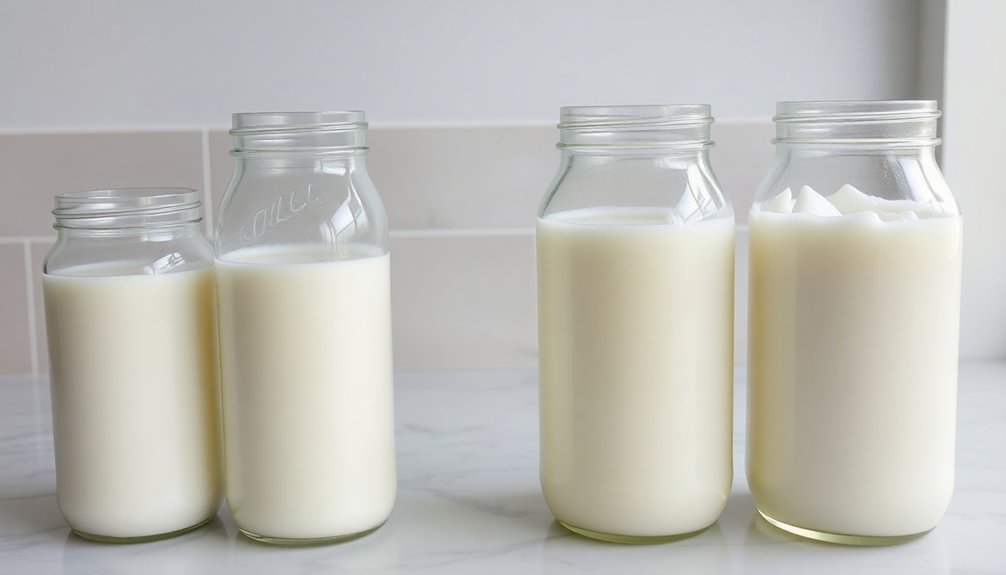
During kefir fermentation, you'll notice your milk gradually thickening as the grains produce kefiran and bacterial cultures multiply.
As fermentation continues, you'll see tiny bubbles forming throughout the mixture, indicating active carbon dioxide production from the yeasts.
If fermentation progresses too far, you'll observe the mixture separating into distinct layers of yellowish whey and white curds, though this doesn't mean your kefir has spoiled.
Texture Thickens Over Time
Over time, milk kefir undergoes significant physical changes as fermentation progresses, resulting in a thickening of its texture.
You'll notice this thickening process happens faster when temperatures are warmer, typically around 28°C, as the fermentation speed increases. However, if you're fermenting in cooler conditions below 21°C, you'll get a thicker, creamier consistency, though it'll take longer – usually 48 hours or more.
The ratio between your kefir grains and milk directly impacts this thickening process. If you're using too many grains for your milk quantity, you'll end up with an overly thick and sour product due to rapid fermentation.
You'll need to maintain the right balance to achieve your desired consistency.
The microbial activity in your kefir also plays an essential role in texture development. When you maintain ideal conditions, the lactic acid bacteria and yeasts work together to create a smooth, uniform texture.
If you're storing your kefir, keep it at 4°C to preserve its texture for up to 10 days.
Remember that seasonal temperature changes can affect your kefir's consistency, so you might need to adjust your fermentation time accordingly.
Whey Separation Process
Physical changes in milk kefir become apparent when whey separation occurs during fermentation, typically between 18-24 hours after starting.
You'll notice a yellow, watery layer (whey) forming at the top of your ferment, while the curds settle below. This separation isn't a sign of spoilage but rather a natural result of extended fermentation or warmer temperatures around 28°C (82°F).
The separation happens because microbial activity breaks down lactose into simpler sugars, producing lactic acid that lowers the pH to 4.0-4.5. As the acidity increases, proteins in the milk begin to coagulate, causing the whey to separate from the curds.
If you'd like to use these separated components, you can strain them for up to two days to achieve complete separation.
You can use the strained curds as a cream cheese substitute, while the whey becomes a versatile ingredient for other fermented products or recipes.
Remember to store both components above 4°C and use them within 10 days. Whether you're making smoothies, pancakes, or other dishes, you can use either the separated or combined components based on your preference.
Bubble Formation Patterns
As you observe milk kefir fermentation, telltale bubbles emerge from the bottom of your jar, signaling the active work of beneficial microorganisms. These bubbles gradually spread throughout the milk as fermentation progresses, creating a distinctive gel-like appearance that indicates healthy fermentation activity.
Temperature plays an essential role in how these bubbles form and distribute. You'll notice faster bubble formation at temperatures between 70-78°F (21-25°C), while cooler temperatures slow this process. The ratio of grains to milk also affects bubble patterns – too many grains can cause rapid bubbling and early separation.
To maintain ideal bubble formation, you'll want to take into account:
- Maintaining consistent temperature to guarantee even fermentation
- Using the right grain-to-milk ratio to prevent overly rapid fermentation
- Gentle agitation once during fermentation to distribute microorganisms evenly
While occasional gentle agitation helps distribute the cultures and promote uniform bubble formation, you'll want to avoid over-agitating your kefir. Excessive movement can disrupt the natural fermentation process and cause uneven bubble distribution.
Ph Levels and Acid Production
The delicate dance of acids and microbes during milk kefir fermentation creates its signature tangy flavor profile.
You'll notice the pH dropping to around 4.5-4.7 after 24 hours as lactic acid bacteria and yeasts break down lactose into various organic acids.
Temperature plays a vital role in this process. At 25°C, you'll get a lower pH of about 4.67, while at 20°C, it'll hover around 4.94. If you let your kefir ferment for too long (48 hours or more), you'll end up with over-acidification, which can negatively impact the taste.
The primary acid you'll find is lactic acid, ranging from 6.43 to 8.31 g/kg, but you'll also get acetic, propionic, and pyruvic acids.
These come from the metabolic activity of bacteria and yeasts in your kefir grains, with LAB counts reaching up to 10^9 CFU/mL. Notably, the amount of kefir grains you use won't greatly affect the final pH, but the fermentation time will.
For the best results, you'll want to maintain temperatures between 20-25°C to achieve the ideal balance of acids and pH levels.
Gas Formation and Bubbles

During milk kefir fermentation, various microorganisms work together to produce carbon dioxide and other gases, creating the characteristic effervescence you'll notice in your brew.
The combination of bacteria and yeasts in kefir grains ferments lactose into lactic acid while simultaneously producing carbon dioxide as a byproduct. You'll find that longer fermentation times result in more carbonation and tangier flavors.
When you consume kefir, the probiotics interact with your gut microbiota, which can lead to additional gas formation. The beneficial bacteria, particularly Lactobacillus and Bifidobacterium, increase in your digestive system, temporarily causing more gas production. Your individual gut composition plays an essential role in how much gas you'll experience.
Key factors affecting gas formation include:
- The duration of fermentation and amount of carbon dioxide produced
- Your personal gut microbiota composition and tolerance to probiotics
- The lactose content and your ability to digest it
If you're experiencing excessive gas, try introducing kefir gradually into your diet.
You can also opt for low-lactose varieties or shorter fermentation times to reduce gas formation while still maintaining the beneficial properties of this fermented drink.
Grain Growth and Development
Successfully maintaining kefir grain growth depends on carefully controlled conditions and proper care techniques.
You'll need to keep the temperature between 22-25°C (68-85°F), as temperatures outside this range can either make your grains sluggish or overly active, potentially leading to stress and separation.
Your grains require proper nutrition through regular feeding with dairy milk, whether it's from cows or goats.
While you can use coconut milk, it's important to alternate it with dairy to maintain grain health. The ratio between grains and milk is vital – too many grains or too little milk can cause early separation and stress.
You'll want to gently agitate your grains during fermentation to guarantee they're making good contact with the milk.
If your grains become too large, carefully break them apart to increase their surface area for better nutrient absorption.
When you need a break from making kefir, store your grains in cold milk to slow their activity.
Remember to avoid metal strainers, direct sunlight, and drafts.
Regular straining and transferring to fresh milk will help maintain continuous grain health and peak fermentation.
Texture and Consistency Changes
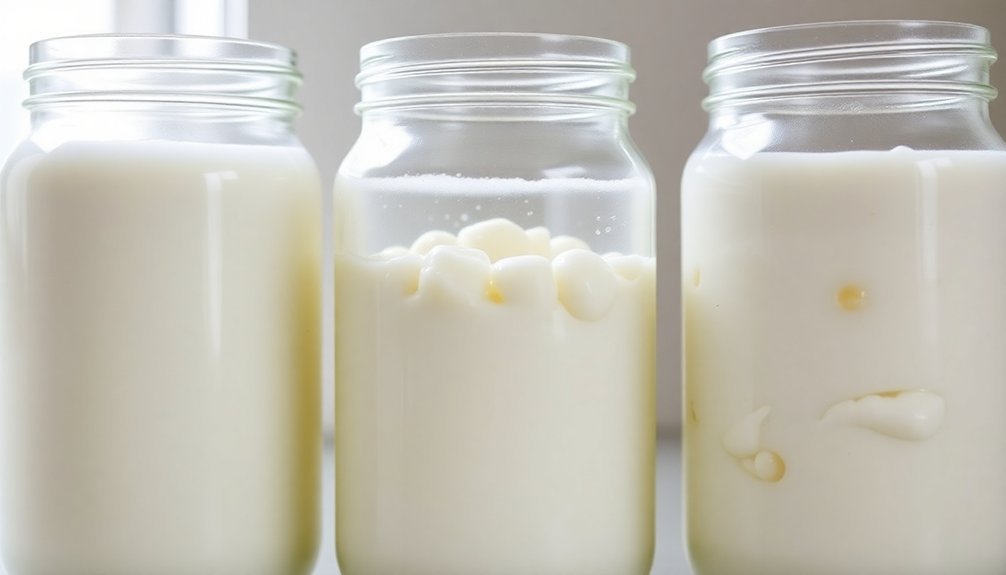
During fermentation, you'll notice your milk kefir transform from a liquid state into a thicker, gel-like consistency as beneficial bacteria produce kefiran.
You'll often see tiny bubbles forming throughout the mixture, indicating active fermentation and the production of carbon dioxide by the microorganisms.
As fermentation progresses, you may observe whey separation, where a clear liquid naturally separates from the thickened milk proteins, especially if the temperature is too warm or there's an imbalance in your grain-to-milk ratio.
From Liquid to Gel
The transformation of milk into kefir involves several complex changes in texture and consistency throughout the fermentation process.
You'll notice that your milk gradually thickens as it shifts from liquid to gel, with temperature playing an essential role in this transformation. When you maintain temperatures between 70-76°F (21-24°C), you'll achieve the most consistent results.
The fat content of your milk directly impacts the final texture. If you're looking for a thicker, creamier kefir, you'll want to use whole milk or cream, while lower-fat options will produce a thinner consistency.
Your fermentation time also matters – a 24-hour period typically yields the best results before separation begins.
- The number of grains you use affects fermentation speed – more grains mean faster fermentation and potentially thinner kefir
- Regular agitation during fermentation helps distribute cultures evenly and promotes better texture
- A second fermentation after straining can enhance thickness and develop more complex flavors
Remember that if your kefir becomes too thin, it's often due to either warm temperatures or an imbalance between the amount of grains and milk you're using.
You can adjust these factors to achieve your desired consistency.
Whey Separation Process
Understanding whey separation in milk kefir helps you control the fermentation process and achieve your desired consistency. When fermentation continues beyond the initial whey bubble, you'll notice clear liquid separating from the thickened milk. This separation occurs more rapidly in warmer temperatures and can indicate that your grains need fresh milk to prevent starvation.
You'll need to monitor your grain-to-milk ratio carefully, as too many grains or insufficient milk can trigger premature separation. Each set of grains requires its own balance, so you'll want to adjust by removing excess grains or adding more milk until you find the right proportion.
Temperature plays a vital role too – you'll get the best results between 70-78°F (21-25°C), with seasonal changes affecting your kefir's consistency.
Be mindful of how you handle your fermenting kefir. While it's tempting to stir frequently, excessive agitation speeds up fermentation and can cause unwanted separation. Instead, stick to occasional gentle rocking of the jar to redistribute the bacteria.
Once you notice the first signs of whey bubbles, it's best to strain your kefir to maintain ideal consistency.
Bubble Formation Pattern
Distinct bubble patterns emerge as milk kefir ferments, starting with small CO2 pockets that gradually expand throughout the mixture.
You'll notice grains floating to the surface as they trap carbon dioxide, though some may sink if they're denser or lack active yeast colonies. As fermentation progresses, these bubbles become trapped within the increasingly gel-like milk structure, transforming its consistency from watery to creamy.
The bubble formation pattern varies depending on several important factors:
- Temperature conditions greatly affect bubble development, with warmer temperatures (70-76°F) producing faster fermentation and more uniform bubble distribution.
- Grain size impacts fermentation speed, as smaller grains create more surface area for bacterial activity and result in more even bubble patterns.
- Seasonal changes influence bubble formation, with summer producing thinner consistency and winter yielding thicker results.
You can optimize bubble formation by maintaining steady temperatures and adjusting your grain-to-milk ratio.
If you notice uneven fermentation, try occasionally stirring to redistribute the grains and promote more uniform bubble development.
Remember that environmental stability is essential for consistent results, as temperature fluctuations can lead to irregular bubble patterns and texture variations.
Time and Fermentation Stages
Making milk kefir involves four key fermentation stages spanning 12-24 hours, with each stage marked by distinct changes in texture and smell.
During the initial stage, you'll add your kefir grains to fresh milk and let them begin their work at room temperature, ensuring the lid remains partially open for proper airflow.
As you enter the second stage around 8-10 hours, you'll notice the milk starting to thicken and develop its characteristic aroma. You can gently rock the jar to redistribute the bacteria, but don't overstir, as this can disrupt the process.
In the third stage, between 20-24 hours, your kefir will reach its desired consistency and develop a pleasantly sour taste.
The final stage signals completion when you observe a crust-like layer forming on top and possibly some clear whey separation. If your kefir hasn't fermented after 24 hours, you can extend the process up to 48 hours.
Remember that temperature plays a vital role – warmer conditions speed up fermentation, while cooler temperatures slow it down.
Once you're satisfied with the fermentation, strain out the grains and store your kefir in the refrigerator.
Flavor Development Process
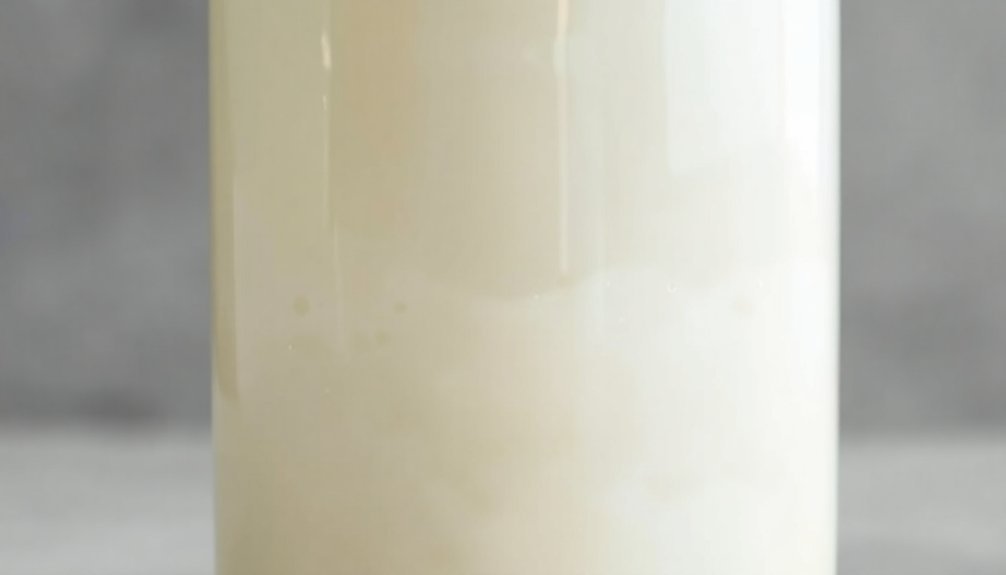
The flavor profile of milk kefir evolves dramatically throughout the fermentation process, shifting from mild to complex as time progresses. You'll notice distinct changes in both taste and texture as the fermentation time increases, from a mild tanginess at 12 hours to a strong, sour flavor with curd separation at 48 hours.
Temperature plays an essential role in how your kefir's flavor develops. When you ferment at the ideal range of 68-72°F (20-24°C), you'll achieve consistent results. Warmer temperatures speed up the process, while cooler temperatures slow it down, requiring you to adjust your culturing time accordingly.
Key flavor developments you'll experience:
- Initial fermentation creates lactic acid through bacterial action, producing the signature tangy taste
- A second fermentation mellows the sharp acidic notes and can introduce carbonation
- Adding flavors during second fermentation lets you customize your kefir with citrus, vanilla, or spices
The microbial activity in your kefir grains breaks down milk proteins and lactose, creating peptides that contribute to the final flavor profile. This process becomes more pronounced the longer you let your kefir ferment, resulting in increasingly complex flavors.
Milk Properties and Adaptations
As your kefir ferments and develops its characteristic flavors, significant changes occur within the milk's molecular structure. The most notable transformation happens when lactobacilli convert lactose into lactic acid, which thickens your milk and creates that distinctive sour taste.
You'll notice the pH dropping as this process continues, fundamentally altering the milk's chemistry.
Your milk's proteins undergo extensive breakdown during fermentation, creating over 1,500 peptides, with 609 being unique to kefir. These protein changes make kefir potentially easier for you to digest compared to regular milk. The microorganisms release external proteases that systematically break down these proteins into biologically active compounds.
You'll observe your milk becoming thicker and creamier as fermentation progresses.
Don't worry if you see a yellow, watery layer (whey) separating – it's a natural sign of fermentation. Your kefir grains will adapt to different milk types, whether you're using cow, goat, sheep, or plant-based alternatives, though they'll need time to adjust.
The adaptation process typically takes 7-14 days, and you'll need to maintain proper temperature conditions to guarantee peak microbial activity.
Frequently Asked Questions
Can Kefir Grains Die if Left Too Long Without Fresh Milk?
Yes, your kefir grains can die if you don't feed them fresh milk regularly. They'll starve after extended periods without nourishment, leading to permanent damage or death of the microbial cultures within them.
Why Do Some People Get Digestive Issues When First Starting Kefir?
You'll likely experience initial digestive issues because your body needs to adjust to kefir's strong probiotics. Start with small amounts (4-6 oz daily) as these beneficial bacteria can temporarily disrupt your gut microbiota.
Does Metal Equipment Affect the Quality of Kefir During Fermentation?
Yes, reactive metals like aluminum and copper can harm your kefir's quality. You'll want to use glass, plastic, or stainless steel equipment instead. Metal can damage the beneficial microorganisms and alter the flavor.
Can You Over-Ferment Kefir to the Point It Becomes Harmful?
You won't usually make harmful kefir through over-fermentation, but it'll taste very sour and curdle. It's only dangerous if you leave it fermenting for extremely long periods, like months or years.
Why Does Homemade Kefir Taste Different From Store-Bought Versions?
Your homemade kefir tastes different because you're using live grains, longer fermentation times, and varying milk types. You'll also notice differences due to temperature fluctuations and secondary fermentation that aren't common in commercial versions.
In Summary
You'll find that milk kefir's transformation during fermentation is a complex interplay of microorganisms, temperature, and time. As the kefir grains work their magic, they break down lactose, produce beneficial compounds, and alter the milk's structure. You can expect changes in texture, acidity, and flavor profiles as fermentation progresses. Understanding these changes helps you achieve your desired kefir consistency and taste.

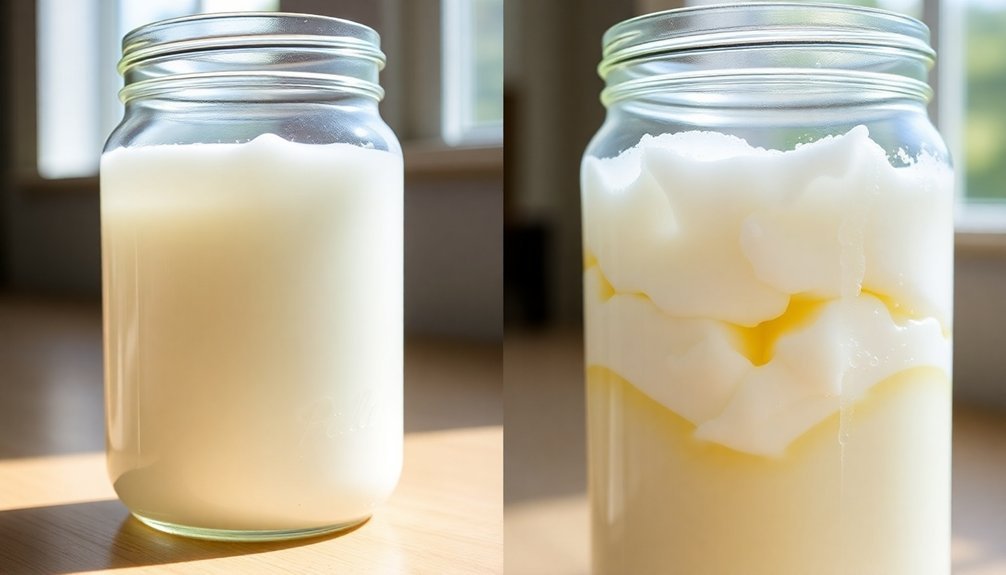



Leave a Reply